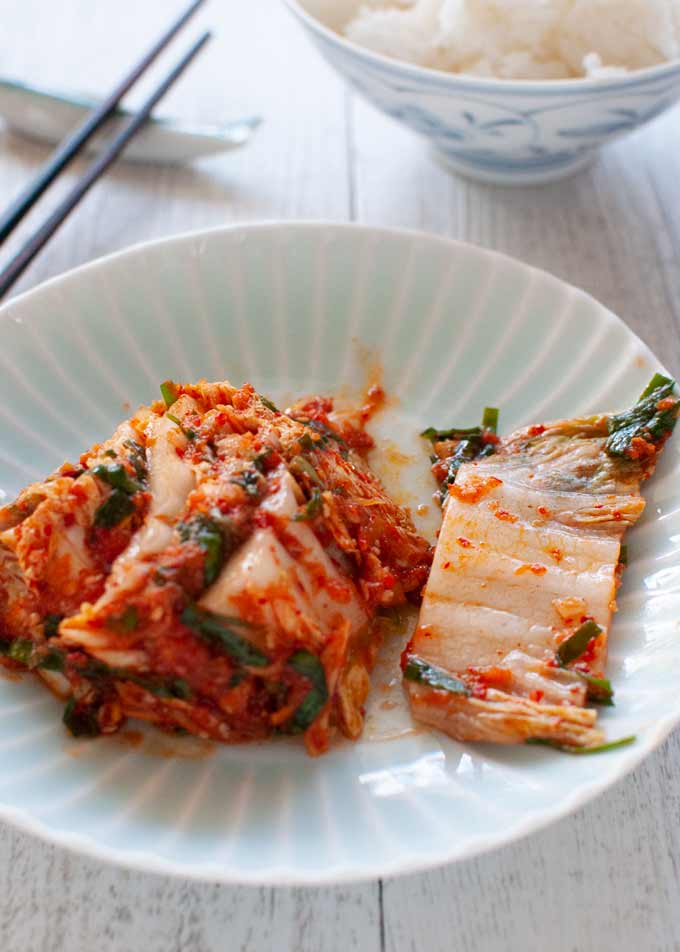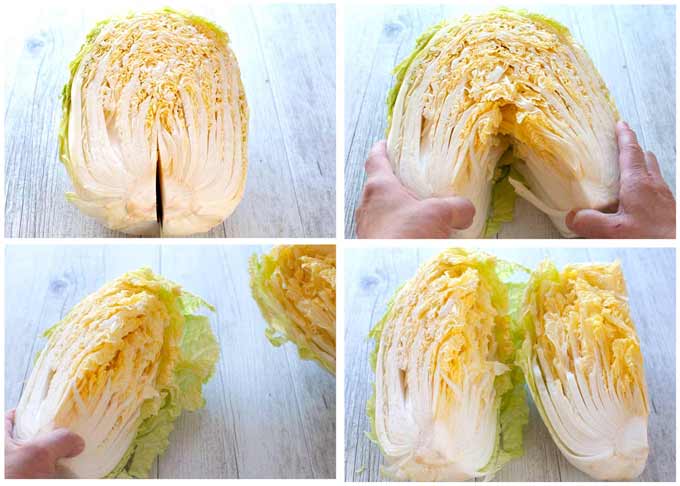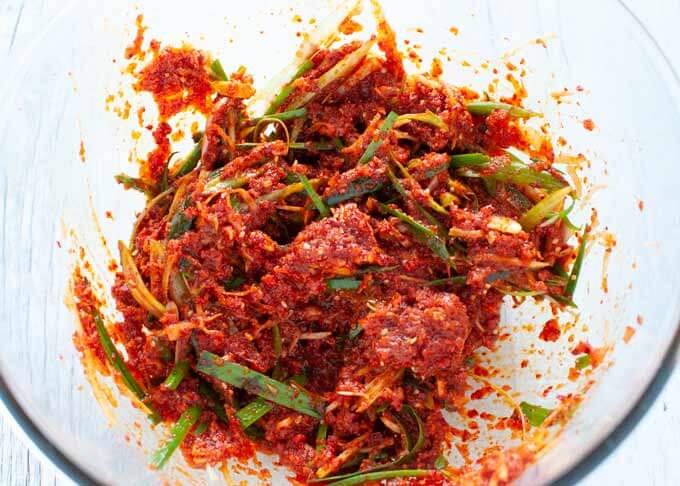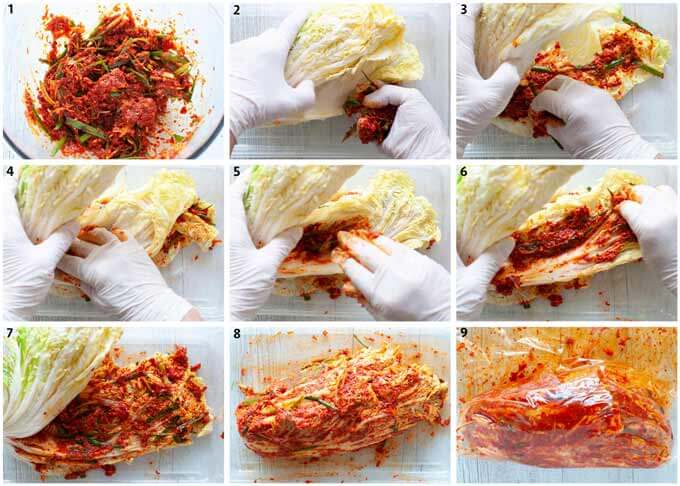My version of Simple Kimchi uses commonly available ingredients. You need a minimum of 3 days to make it, but the actual time required to make Simple Kimchi is only 30 minutes or so.

Kimchi is a staple Korean side dish that is often made from salted and fermented vegetables. Most common kimchi uses Chinese cabbage (also called nappa cabbage or wonbok) and/or daikon with a small amount of other vegetables. They are marinated in a chilli-based marinade paste.
Although it is a Korean dish, many Japanese people like kimchi and they have developed many dishes using kimchi as well.
I used to buy a tub of kimchi from the Asian grocery store but one day I found a recipe in a Japanese magazine that my son brought back many years ago when he went to Japan. So, I started making kimchi at home.
This recipe did not use the shrimp paste that is one of the key ingredients of the kimchi marinade paste. It also adds grated sesame seeds that make the hot chilli flavour of the marinade somewhat milder.

One of the advantages of making kimchi at home is that the flavour is fresh and there is no sourness. Often when you buy a tub of kimchi from a shop, it’s already quite sour due to too much fermentation. I don’t enjoy sour kimchi.
SUN DRYING CHINESE CABBAGE
The traditional Korean way of making kimchi is to sprinkle salt over Chinese cabbage and leave it for a while to get moisture out of the cabbage. This is an important process because otherwise the marinade paste becomes too watery while marinating the vegetables.
My method is to leave a quartered Chinese cabbage in the sun for a couple of days to semi-dry it. You will see that the cabbage shrinks a bit and looks wilted.
When cutting a Chinese cabbage into a quarter, just make an 8-10cm (3-4″) long incision at the stem part. Then hold the separated stem parts and try to pull the cabbage apart. This minimises the leaves cut into small pieces detaching from the stem.
 KIMCHI MARINADE
KIMCHI MARINADE
The kimchi recipe is one of those that varies household by household. It is not right or wrong to have some variations to the ingredients.
My Simple Kimchi marinade consists of chilli powder, roasted sesame seeds, sesame oil, salt, soy sauce, fish sauce, an anchovy, apple and garlic.
Traditional kimchi recipes call for shrimp paste but I substitute it with fish sauce and an anchovy. If you don’t have fish sauce, use extra anchovy + soy sauce.
 ABOUT CHILLI POWDER
ABOUT CHILLI POWDER
In Western cuisine, chilli powder refers to very finely powdered chilli. But for kimchi, you need to use coarse chilli powder like the photo below.
It’s basically a collection of tiny chilli flakes but each piece of flake is so tiny that it looks like powder. Coarse chilli powder is available at Asian grocery stores. I buy the Korean brand (well, kimchi is from Korea, so I can’t go wrong with a Korean brand!) and it comes in a plastic container like the photo or in a large sachet.

MARINATING
Many recipes cut Chinese cabbage leaves into small pieces and then marinate them. But my way of marinating is different and perhaps a bit closer to the traditional method.
I don’t cut the leaves, I keep them attached to the stem when marinating. Then the marinade goes in between the leaves.
Starting from the outmost leaves, open a cabbage leaf, and smudge the marinade paste on the inside of the leaf. Then move onto the next leaf and smudge the paste in the same way. Repeat until the inner-most leaves are covered with the paste.
Coat the outside of the cabbage wedge with the remaining marinade. If nothing is left, don’t worry. There should be a bit of marinade paste overflown from the leaves and you can also take some from between the leaves.

Place the marinated Chinese cabbage in a zip lock bag and store in the fridge. My old recipe says that you can eat it after 3-4 hours of marinating. But kimchi develops a better taste after marinating for 1-2 days.
It keeps for a few weeks or possibly even longer in the fridge. If you leave it too long, though, it is still OK to eat but it becomes sour.
I usually serve kimchi as a side dish in place of Japanese pickles when having a Japanese style meal with rice and miso soup. It also goes well as an accompaniment for drinks.

Yumiko
![]()

My version of Simple Kimchi uses commonly available ingredients. You need a minimum of 3 days to make it, but the actual time required to make Simple Kimchi is only 30minutes or so.
Total Time does not include 2 days of drying Chinese cabbage or marinating time of minimum 8 hours.
- ¼ Chinese Cabbage/nappa cabbage wedge with the stem intact (note 1)
- 2-3 (40g/1.4oz) shallots/scallions, diagonally sliced thinly
- 40g/1.4oz ginger , finely julienned
- 10g/0.6oz garlic chives , cut into 5cm (2”) long pieces (optional)
- 15g/0.5oz roasted sesame seeds , grated
- 30g/1.1oz coarse chilli powder (note 2)
- 50ml/1.7oz sesame oil
- 15g/0.5oz salt
- 25ml/0.8oz soy sauce
- 20ml/0.7oz fish sauce (note 3)
- 1 anchovy (not dried one) , finely chopped (note 3)
- 1 apple , peeled and grated
- 4 cloves garlic , half grated and half finely chopped
-
Place the Chinese cabbage cut sides up on a newspaper and leave it outside in a sunny place for 2 days (note 4).
-
Mix the Kimchi Marinade ingredients well in a bowl. Then add shallots, ginger and garlic chives. Mix well.
-
Place the dried Chinese cabbage, cut sides up on a large plate or a tray. The stem should be on the left and the end of the leaves on the right (for right handers).
-
Starting from the outer-most leaf of the Chinese cabbage, smudge (note 5) the marinade between the leaves, working through one by one to the inner smaller leaves. Make sure that the marinade goes up to the stem end of the leaves.
-
Smudge the surface of the Chinese cabbage with the remaining marinade and make sure that the marinade covers almost every part of the Chinese cabbage leaves (note 6).
-
Place the marinated Chinese cabbage in a large zip lock plastic bag. Transfer any marinade left in the bowl and the plate/tray to the bag.
-
Remove air from the bag as much as possible and seal. Store in the fridge for minimum overnight (note 7).
-
Remove the stem and cut the leaves to 4cm/1½" long crosswise, then plate them (note 8).
1. My Chinese cabbage was about 600g/1.3lb. It is important to cut Chinese cabbage into a quarter vertically with the leaves attached to the stem.
When cutting a Chinese cabbage into a quarter, just make an 8-10cm (3-4") long incision at the stem part. Then hold the separated stem parts and try to pull the cabbage apart. This minimise the leaves cut into small pieces detaching from the stem. (see the photos in the post)
2. Standard chilli powder that is finely powdered is not suitable for this recipe. You can buy coarse chilli powder at Asian grocery stores. It comes either in a plastic container (see the blog for photos) or in a packet.
3. You can substitute fish sauce with 1 additional anchovy and an additional 25ml soy sauce.
Alternatively, you can replace the anchovy with an additional 20ml fish sauce.
4. This is to reduce the amount of water retained inside the Chinese cabbage. You can still make kimchi without drying Chinese cabbage but the marinade becomes quite watery after marinating overnight = a bit watery kimchi.
5. I use disposable latex gloves/medical gloves to do this.
6. If you run out of the marinade before reaching to the last tiny leaves, take some out of the area where a lot of marinade is placed.
7. I find that Kimchi marinated for a couple of days tastes the best. It can stay as is for few weeks in the fridge.
8. When I only need a couple of leaves to serve, I take leaves off the stem from the marinating bag so that the rest can stay as is for further marinating.
Hello Yumiko, I live in Canada and I’m not able to leave out the leaves to dry out in the sun – can this step done indoors instead or on a low setting in the oven? Thank you!
Hi Carmel, you can leave it indoor, next to the bright sunny window. The ultraviolet light increases umami in the leaves.
Hi Yumiko, you use 1/4 of the Chinese cabbage in your recipe – what if I want to use the whole cabbage? Should I just x4 the ingredients you’ve listed? Just sounds a lot but I’m sure you need a lot to marinade!
Hi Esther,
Yes, but use the weight to work out the quantity. My 1/4 Chinese cabbage was about 600g/1.3lb. If your whole cabbage weighs less than 2.4kg / 5.3lb, then the marinade should be less than multiply of 4 (sorry, the serving scaler does not work well in this case).
Hi Yumico I am going to make some sushi rolls by Donna Hay which uses kimchi … I’m definitely going to make your recipe … what I don’t use can in be stored in a glass lidded jar and if so how long would it keep for …
Thank you so much for sharing this recipe- many many thanks sandra
Hi Sandra, yes, glass jar is the best to store Kimchi. It can keep 1 week in the fridge without loosing the original flavour. You can keep it a bit longer but it will start getting sour due to fermentation.
Good morning! I live in Central America and can’t buy kimchi here. I would like to make some. I will have to use bok choi since there is no chinese cabbage in the market. Also, i do have gochu-garu and shrimp paste. How much should i use for 500gr bok choi?
Hi Sonja, gochugaru is basically just chilli so you can substitute it for chilli powder. Shrimp paste can replace fish sauce and anchovies. The weight of Chinese cabbage in my recipe was 600g so you can adjust the quantity of each ingredients accordingly. However, the marinade may not be too much even if you did not reduce the quantity.
Hi Yumiko
How do you grate sesame seeds please? Do you mean in a good processor?
Hi Michelle, I use mortar and pestle. You can grate sesame seed to even paste using them.